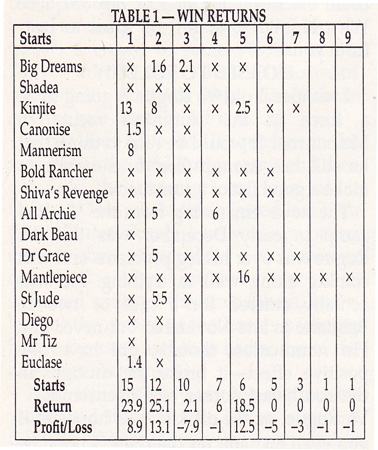THE TEAM
We finished our run through the spring carnival with a definite whimper rather than the bang we started with! The last seven races we bet on failed to produce a winner but we had five placings with three running second, including the unlucky Shiva's Revenge. Nevertheless we finished with a profit of 15.6 units or 26.4% over the 59 bets.
On that note I am already working on the team for this year and will have some early thoughts on that next month.
But for the present let us consider the table which shows the results for each horse with the profit or loss for the starts.

Dedicated followers will recall that at the commencement of this assault on the bookies I suggested a level stake bet on each runner. I also raised the possibility of a staking plan that used smaller units at the beginning of each horse's campaign, building up to larger units as the animal got fitter and supposedly more likely to win. This had been used by the originator of this approach, the late Sydney journalist Pat Farrell. Pat in fact used a sequence of 1, 1, 2, 3, 5, 8 over the first six starts.
Such staking in dollar terms would have not performed as well in percentage of turnover as level staking because of the losses at the tail of spring. An outlay of 138 units showed a return of 25.7 units (18.6%). This result is made much worse if you extend the sequence beyond the six starts as I have done for the level stakes approach. Here, extra bets of 13,21,34 would be needed as this sequence is based on the famous Fibonacci numbers where each number is the total of the two preceding ones. This sequence would have added a further amount of 84 units to the betting total for a loss of 58.3 units. To be fair to Pat, he may have eliminated those horses after six runs or such bets could have resulted in a large profit if one of them won (and that nearly happened).
Pat also varied the sequence by suggesting that when a winner is backed the next bet should be of the same amount rather than moving on to the next figure. This meant that if you backed a winner with 3 units the next bet would be three units again and not five units. This alteration only marginally improves the outcome of these results, however, with a loss of 15.9 units (10% of an outlay of 159).
A similar fate awaited my suggested compromise of 2,2,5,5,8,8. Let's say be six bets we would use level bets of 10 units each time. Here, a total outlay of 277 units saw a return of 9.5 units profit (3.4%).
Obviously I am making a case for level staking, as experience shows me it holds out best through thick and thin, but I have a technique I use to increase bets over time if you are winning or to allow a retreat if you hit a losing run. I also believe that at certain times you must, like a business, declare a dividend and spend some winnings-live a little!
THE ALLCOCK ALTERNATIVE
I work on the basis of 40 bets with the possibility of extending to 60 bets in a bad trot. To give a practical example, let us say you decide you can afford to lose $400, perhaps a negative way to start but a wise precaution anyway. Therefore you can bet in $10 amounts. I do not vary the size of bets from race to race but from day to day. Let us presume that after 10 betting days your bank has risen to $780. That day you have five bets so you outlay $50. One bet wins paying $12, so you win $120 on that race and have a profit of $70 for the day. The bank total is now $850. As the bank has doubled you can declare a dividend of $50 which you rush and spend and now you bet in units of $20. This continues until the bank rises to $1200, from which you take out any excess over that figure and start to bet in $30 units-and so on.
What do you do if the bank, having passed $800, starts to lose? Well, you keep right on with $20 bets until the bank goes below $400 when you again revert to $10 bets until the bank recovers to be over $400 again when $20 bets become the order of the day. If, once more, you lose and go below $400 then-you guessed it-it is back to $10.
Should the bank at any stage go below $200 then either you sit on $10 bets and see if you recover or wipe-out or you can use $5 as a unit-hence the potential of a run of up to 60 losers with this conservative plan.
This plan allows increased bets on the basis of good winnings, a limit on losses which is clearly established at the start and the removal of some profits on the way. Most staking plans do not tell you when to stop and take a cut so you keep on betting until a losing burst costs some or all of the profits. Not this one.
A final note. If you had been on $780 as above and you fluked a winner that paid $600, you do not jump up to $30 bets you still take out all the excess above $800. That is a real nice way to reward yourself for the skill/luck of getting such a winner.
By Clive Allcock
PRACTICAL PUNTING - JANUARY 1992